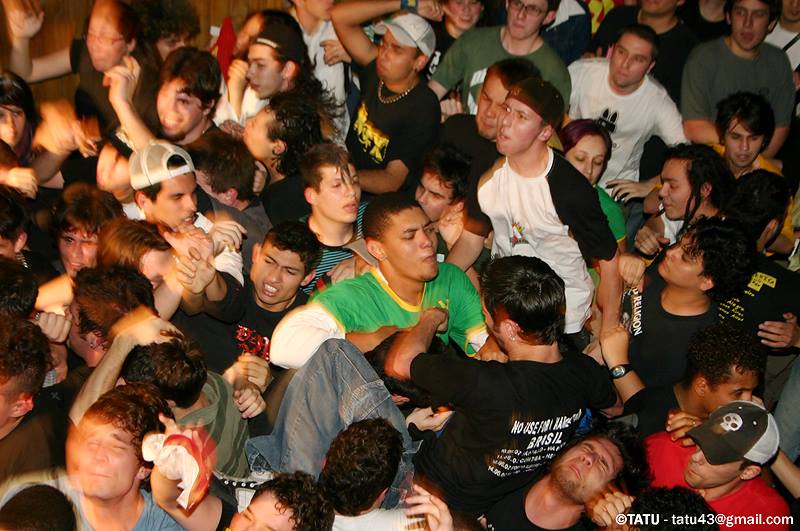Each concert has its own standards for audience behaviour. If you go to a Death Grips show, you just have to expect that things are going to get a little out of hand. No one will be sitting cross-legged on the floor. But there are concerts (at least in my experience) where the standards of behaviour are not altogether clear. There isn’t exactly a guidebook on moshing. Nonetheless, from concert to concert, there is usually just some unspoken rapport amongst audience members about the kind of environment to expect. But there are also plenty occasions where there is no such rapport, and the presence or absence of moshing can either make or break a concert experience.
Now, I don’t want to outright criticize the practice of moshing. Sometimes it’s perfectly concomitant with enjoying certain types of music. After all, you don’t go to see a dance music concert and expect not to dance. As for myself, I usually keep a pretty low profile no matter what the music is, but when I find myself at the front of a Fucked Up show being crushed between the stage and a bunch of sweaty people, I can hardly complain. As uncomfortable as that may sound, it would probably be worse if everyone just stood still and sipped their beers while the front man screamed into the mic.
But consider two occasions in which the practice of moshing can seriously damage others’ enjoyment of a concert. The first example is during a Mac Demarco concert in 2014 at the Rialto. Because he was previously based in Montreal, Demarco has an especially rabid cult following in the city. As a result, the Rialto was filled by a bunch of hyped-up fans eager to get as close to Demarco as they could in the hopes of getting the musician’s attention and taking part in the kind of antics coherent with his goofball persona (from getting a Snapchat with him, to stealing a kiss—even groping, etc). Demarco is well known for his odd public persona, and though he never directly incited the crowd to do anything crazy, he has clearly invited some pretty wild behaviour at his shows (partly through leading by example).
However, if you’re familiar with his music, you’ll know that his recordings don’t actually get the blood pumping. It’s great music, but I’d much sooner walk to school to ‘Viceroy’ than turn up to it. Not only does moshing feel misaligned with Demarco’s music, but also, the front half of this audience was so out of hand that some decided to rush the stage during the middle of his set. As a result, they tripped over cables, bumped into musicians, and ultimately interrupted the set. No one was seriously hurt, but this alone doesn’t make the incident an instance of harmless fun. It’s not always a matter of just making sure that no one is physically hurt, but also a matter of respecting everyone’s personal boundaries. Besides, it’s also worth noting that ‘moshers’ are almost always in the minority, so a chance at groping Mac Demarco for a half second is not worth everyone else’s annoyance.
Moreover, this kind of playful but aggressive behaviour can also work to seriously exclude those who are not physically capable of dealing with bodies being constantly thrown at them. This concern was highlighted at a concert at La Tulipe last summer, which featured (among other bands) Ought, a post-punk band that plays some arguably mosh-able music. Predictably, there was a group of guys ready to mosh at the front of the stage, but after a few songs, front man Tim Darcy politely asked them to go “jostle around in the back if they wanted to.” The band has noted in an interview with Stereogum that when moshing takes place at their shows, they have sometime observed a “shift in demographic” of those occupying the front row; and though I’m sure most moshers have no intention of excluding others, when you find that groups of people are not able to properly enjoy your show because of an enclave of sweaty shirtless dudes tackling each other, it is perfectly legitimate to tell people to settle down. If anything, concerts ought to be an equalizing experience, where everyone in attendance is brought together out of their appreciation of the same music.
This method of dealing with moshing contrasts with Demarco’s, who did nothing to involve himself in the disaster that was unfolding at his show, keeping a smile on his face and maintaining his ‘chill’ persona. He might have been reasonably concerned about not coming on too strong to his fans by telling them to calm down, but surely this kind of face-saving is not worth letting a rowdy few interrupt the performance. Besides, if anything, those mosh-ready audience members are most likely to listen to the actual musician that they’ve paid to see, not the security guards tackling them off the stage.
But, at the same time, physical engagement with music is, for many people, a large part of the enjoyment. There’s a legitimate tension for allowing this kind of engagement and making sure that everyone gets the respect they deserve as concertgoers. But as mentioned earlier, the rapport amongst audience members about moshing cannot be readily communicated, so it really falls upon the artists to communicate the kind of environment they want to accompany their music. Granted, this can be awkward when the mood communicated music doesn’t match the kind of environment the artist wants to create (arguably in the case of Ought). Even EDM DJs have interrupted their own sets to tell people to stop moshing and appreciate the music. When there is a widespread disconnect between the audience and the artist’s expectations, the risk of creating an alienating environment is also troubling. Scenarios like these suggest that it is ultimately up to the concertgoers, not the artist, to decide what kind of environment is best for each concert.
Ultimately, I think the elevated voice that artists have in concerts means that the responsibility lays with them. But this doesn’t mean the artist gets to dictate exactly how people behave in a concert. After, all ‘jostling around’ can be a serious component of enjoying a live performance, providing that everyone is included. Artists’ preferences in this regard should be measured against what the majority of their audience want in the performance. Singling out a few rowdy fans is a good call, but if your whole audience has showed up to bounce off the walls, you might just want to play to the crowd.


